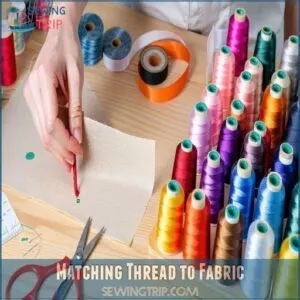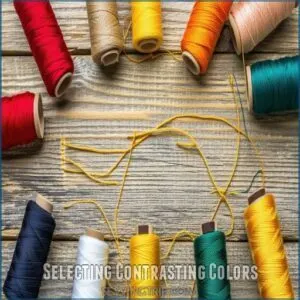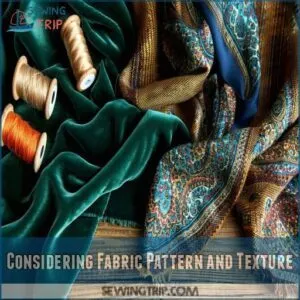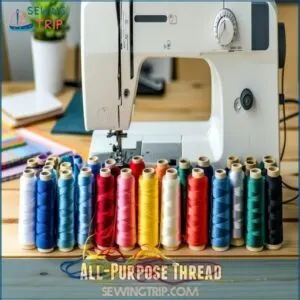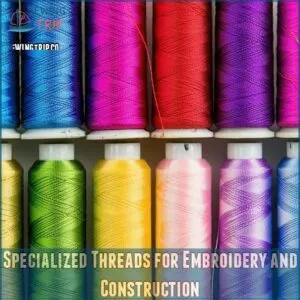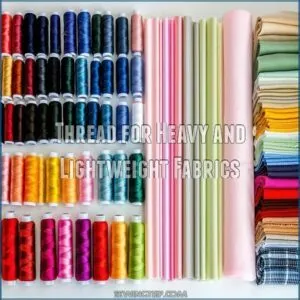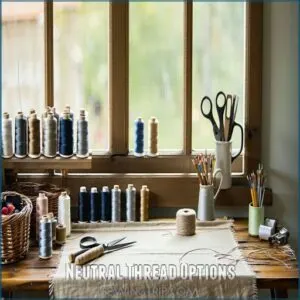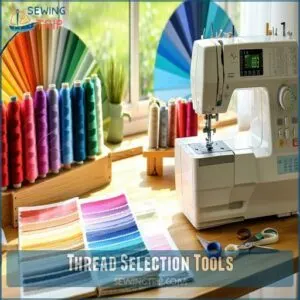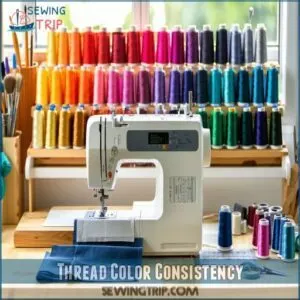This site is supported by our readers. We may earn a commission, at no cost to you, if you purchase through links.
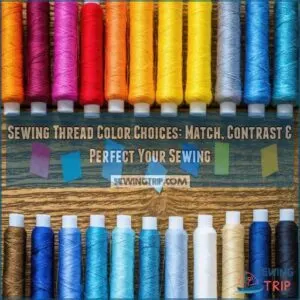 Choosing sewing thread color is all about balance and creativity.
Choosing sewing thread color is all about balance and creativity.
For a seamless look, match the thread to your fabric’s background color, or go a shade darker—it hides stitches like magic.
Feeling bold? Go for contrasting colors to make your designs pop.
Neutral tones like gray, beige, or navy are lifesavers when an exact match isn’t handy, blending effortlessly with most fabrics.
For patterned or textured fabrics, focus on the dominant color or texture to keep things harmonious.
And don’t skip on good lighting or fabric swatches—they’ll save you guesswork.
Ready to experiment? Let your thread tell the story!
Table Of Contents
Key Takeaways
- For a seamless look, you’ll want to match your thread to the fabric’s background color or go one shade darker – this helps hide stitches effectively while maintaining a professional finish.
- You can use contrasting thread colors to create bold, eye-catching designs – just be sure to use the color wheel to find complementary or analogous color combinations that work well together.
- Keep neutral threads like gray, beige, and navy in your collection – they’re versatile lifesavers that blend well with most fabrics when an exact match isn’t available.
- You’ll get better results by testing your thread color under different lighting conditions and buying extra thread from the same dye lot to maintain consistency throughout your project.
Choosing Thread Color
Choosing the right thread color can make your sewing projects look polished and professional.
Whether you want your stitches to blend in or stand out, it’s all about balancing color, fabric, and creativity.
Matching Thread to Fabric
Picking thread isn’t rocket science, but matching it to fabric can feel tricky.
Stick to this:
- Choose a thread that blends with the fabric shades or background color.
- Can’t find a perfect match? Go slightly darker; it hides better.
- Bring a fabric texture swatch when shopping for color harmony.
For more information on thread quality and its impact on sewing, consider the factors that affect seam reliability.
This keeps seams clean and thread visibility low.
Selecting Contrasting Colors
If matching feels too safe, contrast can pack a visual punch.
Use Contrast Theory to create bold designs—pairing a complementary hue or experimenting with color harmony rules like analogous shades.
Tint variation offers softer effects, while strong hues add drama.
Think bright red stitching on navy or yellow on teal, it’s all about making that thread pop with drama.
Considering Fabric Pattern and Texture
When fabric patterns and textures come into play, thread choice takes a thoughtful twist.
Match thread to dominant colors but also factor in the design’s vibe. For success: Understanding thread selection basics is key to making informed decisions.
- Pattern mixing? Stick to the base color for balance.
- Bold textures? Use subtle thread to let drape shine.
- High contrast? Emphasize color harmony over loud thread visibility.
Thread Types and Uses
You’ve mastered matching and contrasting threads, so now let’s explore different thread types and their best uses.
Understanding these distinctions will help you choose the right thread for every project, from delicate silks to sturdy denim.
All-Purpose Thread
All-purpose thread is your go-to for most sewing projects.
This versatile option handles various fabrics and stitch types with ease, making it ideal for basic garments or home décor.
Plus, it minimizes color variance, ensuring smooth fabric blending.
The quality of sewing thread is essential for achieving professional results.
For hidden stitches or visible seams, its thread durability keeps your projects looking sharp without breaking the bank.
Specialized Threads for Embroidery and Construction
Beyond everyday sewing, specialized threads elevate your Embroidery Materials and Construction Threads game.
Rayon and polyester shine for machine embroidery, boasting vibrant colors and durability. Cotton offers a matte look, while silk complements delicate fabrics.
Metallic threads add sparkle, but test your Sewing Techniques. To achieve ideal results, selecting the best machine embroidery thread is essential for your project’s success.
Consider Fabric Selection and Thread Weights for the best outcome with your Construction Threads.
Thread for Heavy and Lightweight Fabrics
Thread weight matters as much as fabric thickness.
For heavy-duty fabrics like denim or canvas, grab thicker threads—they’re built to handle the load.
For delicate, lightweight fabrics like chiffon, opt for finer, lightweight options to avoid puckering.
Understanding thread selection basics is vital for achieving the perfect balance between thread and fabric.
Matching thread to fabric density is essential for durability and keeps your project looking sharp.
Trust the right weight for stress-free sewing.
Neutral Thread Options
Neutral thread options are your go-to for versatility when matching isn’t easy or practical.
With shades like gray, beige, or even navy, you can blend stitches seamlessly into your fabric while keeping your sewing stress-free.
Gray and Beige Thread for Versatility
When you’re unsure which thread to pick, neutral tones like gray or beige are lifesavers.
Gray threads work wonders blending with cooler shades, while beige suits warmer fabrics seamlessly.
If you’re looking for quality options, gray thread for sewing can be a great choice for your projects.
These versatile shades complement various fabric blending needs, making them perfect for general sewing. Keep a few thread weights handy—they’re your go-to for quick, clean results.
Black, Brown, and Navy for Dark Fabrics
Don’t let dark fabrics throw you off—black, brown, and navy thread blend effortlessly into textured or deep-toned fabrics.
When choosing dark neutrals, match thread tones closely, as they offer versatility for nearly all sewing projects.
For uneven lighting, darker threads hide imperfections like magic.
Dark colors for texture-rich fabrics are key to a polished, seamless look.
White and Pastel Thread for Light Fabrics
For light fabrics, pastel thread combinations like soft pink or pale blue keep stitches discreet.
These subtle tones are excellent for delicate patterns or sheer materials, and choosing subtle tones guarantees light fabric suitability without overwhelming designs.
Think pastels – they’re like the friendly neighbor stitches barely notice, and white thread alternatives, such as off-white or pearl gray, work wonders for smoother blending.
Thread Selection Tools
Choosing the right thread doesn’t have to be a guessing game when you’ve got the right tools.
Use handy resources like thread sample books and color wheels to match or contrast with confidence every time.
Thread Sample Books for Comparison
When neutral threads aren’t enough, thread sample books are lifesavers.
These handy guides include real thread swatches, making fabric matching a breeze. Thread Sample Books are especially invaluable for comparing various color options with precise reference swatches.
Whether you’re comparing thread charts or flipping through color cards, seeing actual samples beats guessing every time.
Keep one handy for precision and fewer mismatches—because no one wants stitches that scream, “Wrong shade!”
Using The Color Wheel for Thread Selection
Remember those thread sample books we just talked about?
Pair them with a color wheel to open up endless possibilities.
Experiment with complementary color pairing for subtle pops, or try analogous color blending for a cozy, harmonious look.
Want bold? Triadic harmony usage adds drama.
Play with vibrancy adjustments exploration or color value contrast to make stitches stand out confidently.
Considering Thread Fiber Content and Quality
Picking the right thread isn’t just about color—fiber-based durability and strength matter, too.
Quality testing methods can help you spot dependable options. Look for:
- Thread strength comparison on labels.
- Thread elasticity factors for stretchy fabrics.
- Smooth, consistent surfaces to avoid fraying.
- Eco-friendly thread alternatives for sustainable projects.
Fibers matching your fabric’s weight and purpose are important. For expert advice on thread weight selection, consider how fabric thickness influences both durability and appearance.
Thread Color Consistency
Keeping your thread color consistent throughout a project is key to achieving a polished finish.
It might seem like a small detail, but mismatched shades can stand out in all the wrong ways.
Maintaining Consistency in Thread Color
Consistency is key when sewing!
Test thread under different lighting to guarantee the shade stays true. Always check for dye lot variations—matched dye batches prevent surprises.
Practice colorfastness testing methods by washing or ironing a sample thread. Store threads properly to avoid fading—no windows, no sun.
For more accurate results, consider referencing thread color systems used by manufacturers to help identify consistent color matches. A few small steps will keep your project looking seamless!
Factors Affecting Thread Color Consistency
Lighting impacts thread color more than you’d think—what looks perfect in-store might clash at home.
Dye lot variations can create subtle differences, so always buy extra thread.
Fabric absorption effects can shift hues, especially on natural fibers.
Thread aging factors, like brittleness, also matter.
Tips for Achieving Professional-Looking Results
Getting that polished, professional look isn’t just about matching colors—it’s nailing the details.
To perfect your work:
- Adjust thread tension for smooth, even stitch quality.
- Prioritize sewing accuracy by controlling fabric movement.
- Check color harmony under good lighting for fabric finishing.
- Test and tweak on scraps to avoid mistakes.
Master these, and your projects will wow with a professional touch!
Frequently Asked Questions (FAQs)
How do I choose the best thread color for piecing & sewing?
Ever wonder why some seams pop more than others?
Match thread to your fabric’s base color.
If unsure, go slightly darker.
For patterns, align with the dominant shade.
Neutral tones work wonders universally!
How to select the correct color thread?
Match thread to your fabric’s main color for a seamless look.
Can’t find an exact match? Go darker, not lighter.
For bold stitches, pick a contrasting or complementary shade—it’s all about creating balance or pop!
How do I choose the right thread for my fabric?
Think of thread as your fabric’s wingman.
Match it to the dominant color for harmony, or pick a shade darker for blending.
For thinner or thicker fabrics, adjust thread weight to match its strength.
What type of thread is best for sewing?
Go for all-purpose polyester thread for most projects—it’s durable, stretchy, and works on almost any fabric.
Use cotton thread for natural fabrics like linen or quilted pieces.
Match thread weight to your fabric’s thickness.
How do I choose a thread color for topstitching?
Pick a thread color that pops!
Contrasting colors like complementary shades or bold hues work wonders.
Use a color wheel to explore combos, and don’t shy away from triad harmonies for striking topstitching effects.
What are the different types of sewing threads?
You’ll find all-purpose polyester thread for everyday sewing,
cotton thread for natural fabrics,
silk thread for delicates.
Heavy-duty thread is available for upholstery,
and there are also specialized threads like metallic or quilting for unique projects.
How do I choose thread color for sewing?
Match thread to your fabric’s main color, going slightly darker if you can’t find an exact match.
For construction, stick to neutral tones like gray or beige, but feel free to use contrasting colors for topstitching.
How would you choose the appropriate color of the thread?
Pick a thread that matches your fabric’s main color, or go slightly darker if you can’t find an exact match.
For fun, try contrasting colors in topstitching.
Gray and beige work well as neutrals.
Should thread be lighter or darker than fabric?
Want your stitches to blend seamlessly?
You’ll want to go slightly darker than your fabric – it’ll blend better with shadows and look more polished.
If that’s not possible, aim for an exact match.
What are the most versatile thread colors?
You’ll get the most mileage from mid-tone gray and beige threads – they work with nearly everything.
Stock up on black, white, and navy too.
They’re your go-to colors for most projects.
Conclusion
Like threads woven through fabric, mastering sewing thread color choices transforms your projects from good to exceptional.
Whether you’re matching colors for seamless results, creating bold contrasts for dramatic effects, or keeping it simple with versatile neutrals, your thread selection matters.
Remember to test your choices in different lighting, keep a well-stocked collection of basics, and trust your creative instincts.
With these tips in hand, you’ll make confident thread choices that elevate every stitch you sew.
- https://www.thesprucecrafts.com/choose-sewing-thread-color-type-and-fibers-2978366
- https://www.tailors-world.com/en/bussiness-en/choosing-the-right-thread-for-your-sewing-needs/
- https://auribuzz.com/2016/05/10/thread-matters-choosing-the-right-color/
- https://www.threadsmagazine.com/2020/05/15/dont-match-your-thread
- https://www.superiorthreads.com/education/silk-thread-faq

